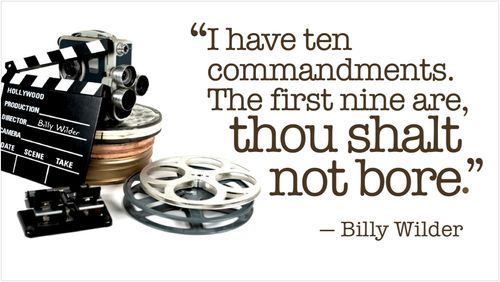Translating Wilder: Ten Rules of Good Screenwriting
From the Argh Draft Vault, dated Dec. 23, 2013, but updated and finished today:
I just found Billy Wilder’s famous ten rules of good filmmaking, and they translate pretty well to novel writing. Well, I can translate them into novel-writing. I don’t agree with the first one, but I think that might be semantics; the rest are absolutely applicable. So here are Wilder’s rules and my translations into novel speak:
1: The audience is fickle.
I don’t think readers are fickle: if you deliver good story, they’ll come back. But I do think that most readers want their favorite writers to keep writing the same story, the one they like, and they’ll leave the writer who doesn’t do that. I understand this, I don’t read anything by Dick Francis that doesn’t have horses and death in it, but it is frustrating for writers who have other stories to tell.
2: Grab ‘em by the throat and never let ‘em go.
Yep. Start your story (which is your conflict) on the first page and keep building it until it’s resolved on the last page (which is the end of your conflict). Don’t mosey.
3: Develop a clean line of action for your leading character.
Character is action. Your character has a goal she desperately needs. She goes after it deliberately and logically with no veering off course. If you garbage up her line of action with extraneous stuff, you obscure your story.
4: Know where you’re going.
Always know the ending before you start. If possible, know the climactic scene before you start. If you don’t know where you’re going, you won’t be able to figure out how to get there.
5: The more subtle and elegant you are in hiding your plot points, the better you are as a writer.
I’m not clear what Wilder means here. If he’s saying “Don’t announce what each move means,” then I’m with him. But I do think there has to be a clear plot through line that the reader can follow without a problem I’m pretty sure that’s he says in #3 above. So I’m going to go with, “Avoid on-the-nose and as-you-know dialogue and never explain what things mean; your reader is not stupid.”
6: If you have a problem with the third act, the real problem is in the first act.
Or, “If your ending sucks, it’s because you blew the beginning.”
This is one of the many reasons you write the first scene last (or at least rewrite it last): the beginning sets up the ending by promising the reader that THIS is what the story is about, this outrage, this injustice, this danger to someone we care about. If you make that promise in the beginning and invest the reader in the outcome of that promise, you then know that you have to fulfill that promise at the end.
7: A tip from Lubitsch: Let the audience add up two plus two. They’ll love you forever.
Never talk down to your readers, never assume they’re too dumb to get what you’re doing. You’re partners in this story, they help you write it as they read it, so treat them as equals or better.

8: In doing voice-overs, be careful not to describe what the audience already sees. Add to what they’re seeing.
We don’t do voiceovers in fiction, we do internal monologue, and we’re a lot less likely to describe the action because we’re a lot less likely to write the action. So for fiction, I’d reverse this to “In doing internal monologue, be careful to keep the bodies in motion on the page, characters in action as the POV character thinks. The actions should be in contrast to the internal thoughts, not just the illustration of what the POV character is thinking.”
9: The event that occurs at the second act curtain triggers the end of the movie.
The end of the second act in movie-making is the Crisis or dark moment . . .
10: The third act must build, build, build in tempo and action until the last event, and then — that’s it. Don’t hang around.
Absolutely. Once your protagonist is stable again, get the hell out. Your story is over.
Oh, and this, in spades:

The post Translating Wilder: Ten Rules of Good Screenwriting appeared first on Argh Ink.




